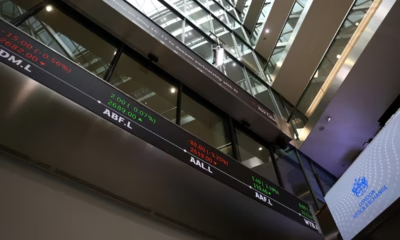Politics
A New Fiscal Playbook How UK Economic Strategy Confronts Global Pressures

Introduction
The United Kingdom stands at a pivotal economic moment, facing rising global pressures, volatile markets, and growing demands for public investment. After years of pandemic disruption, inflation shocks, and geopolitical turbulence, the government is reshaping its fiscal playbook to balance growth, stability, and credibility. The strategy emerging from Westminster reflects both necessity and pragmatism: a recalibration of spending, taxation, and industrial priorities designed to preserve economic resilience while navigating an unpredictable global environment.
According to the Office for National Statistics, the UK economy grew by just over half a percent last year, lagging behind the United States and much of the eurozone. Inflation remains above the Bank of England’s two percent target, public debt exceeds ninety-eight percent of GDP, and productivity growth continues to disappoint. Against this backdrop, fiscal policy has become the primary instrument through which the government seeks to restore confidence at home and competitiveness abroad.
The Shift from Crisis Management to Strategic Planning
In recent years, UK fiscal policy has largely been reactive, shaped by a succession of crises. The pandemic demanded extraordinary public spending, while the energy shock following global supply disruptions led to massive state intervention. The new challenge lies in transitioning from emergency measures to a coherent long-term plan.
The Treasury is emphasizing discipline and predictability, promising that new spending commitments will be matched by credible financing. The objective is to reassure investors that the government can balance support for growth with fiscal responsibility. Bank of England officials have echoed this stance, warning that fiscal excess could undermine efforts to bring inflation under control.
Public Investment and the Growth Dilemma
The debate now centers on how to stimulate growth without widening fiscal deficits. The government’s response has been to focus on targeted public investment in infrastructure, energy, and technology. Initiatives to expand green industries, upgrade transport networks, and strengthen digital connectivity have been prioritized as long-term productivity drivers.
Economists from the International Monetary Fund note that well-structured public investment can yield high returns if paired with effective regulation and private sector participation. The UK Infrastructure Bank and British Business Bank have been tasked with mobilizing capital for sustainable growth sectors. However, execution risks remain, especially as budget constraints tighten and local authorities face funding gaps.
Tax Policy and Political Pressure
Fiscal credibility depends as much on taxation as on spending. The government is seeking to maintain steady revenue while signaling competitiveness to global investors. Corporation tax reforms and targeted reliefs for innovation and capital investment are part of this effort. Yet political pressure for broader tax cuts is intensifying as households continue to face a cost-of-living squeeze.
The challenge lies in balancing political timing with economic prudence. Cutting taxes too quickly could reignite inflation or increase borrowing costs. The Treasury has therefore opted for gradual adjustments, focusing first on business incentives and productivity-related reliefs rather than broad consumer measures. Reuters data indicate that markets have responded positively to this caution, with gilt yields stabilizing after earlier volatility.
The Global Context of Fiscal Policy
The UK’s fiscal strategy cannot be divorced from global conditions. The slowdown in China, monetary tightening in the United States, and ongoing conflicts affecting energy and trade have all influenced economic priorities in London. A strong dollar and shifting capital flows have tested the resilience of sterling, prompting the government to coordinate closely with the Bank of England on currency stability.
At the same time, the European Union and United States are deploying large-scale industrial subsidies, forcing the UK to reconsider its competitive position. The government’s approach seeks to avoid direct subsidy competition, instead emphasizing regulatory flexibility, global partnerships, and financial innovation as comparative advantages. This strategy reflects both constraint and opportunity within post-Brexit realities.
Debt Management and Market Confidence
Maintaining investor confidence is central to the new fiscal playbook. The memory of market turbulence following previous fiscal missteps remains fresh among policymakers. Since then, the Treasury has prioritized transparency in borrowing plans and coordination with monetary policy.
Public sector borrowing has fallen from its pandemic-era highs but remains sensitive to interest rate movements. The Office for Budget Responsibility projects that debt servicing costs will consume a growing share of revenue if rates stay elevated. This underscores the need for cautious fiscal expansion, supported by sustainable debt management and credible medium-term forecasts.
The Role of the Private Sector in Growth
A key feature of the UK’s evolving economic model is a stronger reliance on private investment. The government is encouraging pension funds, sovereign wealth funds, and institutional investors to support domestic projects in infrastructure, green energy, and technology. The Mansion House reforms aim to unlock billions in long-term capital by adjusting regulatory frameworks and improving returns for savers.
Early signs of progress are visible. Major investment commitments have been announced in renewable energy, battery manufacturing, and life sciences. However, experts warn that regulatory clarity and stable policy direction are critical for sustaining momentum. Frequent changes in planning or taxation could deter the very investors the government hopes to attract.
Regional Growth and Levelling Up
Fiscal policy is also being used as a tool to rebalance economic geography. The government’s levelling-up agenda seeks to reduce disparities between London and the rest of the country through targeted regional investment. Yet delivery has been inconsistent, with some projects delayed due to local funding shortfalls.
Regional leaders are calling for greater fiscal autonomy, arguing that local control over taxation and investment could improve efficiency. The Treasury has begun exploring pilot schemes for devolved fiscal powers, though progress remains cautious. The balance between central oversight and regional flexibility continues to shape the broader debate about national economic strategy.
Political and Market Implications
As the next election approaches, fiscal policy will remain under intense scrutiny. Markets are watching whether the government can maintain credibility while offering voters relief from economic strain. Both major parties are framing their economic platforms around fiscal stability, suggesting that consensus may be emerging around disciplined but flexible policymaking.
City investors view predictability as the ultimate measure of success. Clear communication, data transparency, and consistent policy implementation are essential for sustaining investor confidence in UK assets. The ability to align fiscal and monetary objectives will define the credibility of the broader economic strategy.
Conclusion
The UK’s new fiscal playbook reflects a recognition that stability and growth must coexist in a volatile global economy. The government’s challenge is to sustain discipline without suppressing innovation or investment. If executed effectively, this approach could restore confidence and create the foundation for long-term competitiveness.
London’s financial markets and global investors are watching closely. Success will depend not only on policy design but on consistent delivery, coordination, and clarity. The United Kingdom’s ability to manage this delicate balance will determine whether its economic strategy becomes a model of resilience or a cautionary tale in an era of global uncertainty.



















